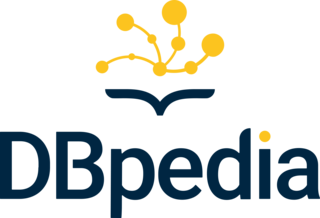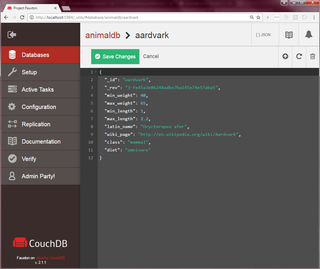
The Semantic Web, sometimes known as Web 3.0, is an extension of the World Wide Web through standards set by the World Wide Web Consortium (W3C). The goal of the Semantic Web is to make Internet data machine-readable.
The Resource Description Framework (RDF) is a World Wide Web Consortium (W3C) standard originally designed as a data model for metadata. It has come to be used as a general method for description and exchange of graph data. RDF provides a variety of syntax notations and data serialization formats, with Turtle currently being the most widely used notation.

Django is a free and open-source, Python-based web framework that runs on a web server. It follows the model–template–views (MTV) architectural pattern. It is maintained by the Django Software Foundation (DSF), an independent organization established in the US as a 501(c)(3) non-profit.

Semantic MediaWiki (SMW) is an extension to MediaWiki that allows for annotating semantic data within wiki pages, thus turning a wiki that incorporates the extension into a semantic wiki. Data that has been encoded can be used in semantic searches, used for aggregation of pages, displayed in formats like maps, calendars and graphs, and exported to the outside world via formats like RDF and CSV.
Oracle Spatial and Graph, formerly Oracle Spatial, is a free option component of the Oracle Database. The spatial features in Oracle Spatial and Graph aid users in managing geographic and location-data in a native type within an Oracle database, potentially supporting a wide range of applications — from automated mapping, facilities management, and geographic information systems (AM/FM/GIS), to wireless location services and location-enabled e-business. The graph features in Oracle Spatial and Graph include Oracle Network Data Model (NDM) graphs used in traditional network applications in major transportation, telcos, utilities and energy organizations and RDF semantic graphs used in social networks and social interactions and in linking disparate data sets to address requirements from the research, health sciences, finance, media and intelligence communities.

Eclipse RDF4J is an open-source framework for storing, querying, and analysing RDF data. It was created by the Dutch software company Aduna as part of "On-To-Knowledge", a semantic web project that ran from 1999 to 2002. It contains implementations of an in-memory triplestore and an on-disk triplestore, along with two separate Servlet packages that can be used to manage and provide access to these triplestores, on a permanent server. The RDF4J Rio package contains a simple API for Java-based RDF parsers and writers. Parsers and writers for popular RDF serialisations are distributed along with RDF4J, and users can easily extend the list by putting their parsers and writers on the Java classpath when running their application.

DBpedia is a project aiming to extract structured content from the information created in the Wikipedia project. This structured information is made available on the World Wide Web using OpenLink Virtuoso. DBpedia allows users to semantically query relationships and properties of Wikipedia resources, including links to other related datasets.

Apache CouchDB is an open-source document-oriented NoSQL database, implemented in Erlang.
A semantic reasoner, reasoning engine, rules engine, or simply a reasoner, is a piece of software able to infer logical consequences from a set of asserted facts or axioms. The notion of a semantic reasoner generalizes that of an inference engine, by providing a richer set of mechanisms to work with. The inference rules are commonly specified by means of an ontology language, and often a description logic language. Many reasoners use first-order predicate logic to perform reasoning; inference commonly proceeds by forward chaining and backward chaining. There are also examples of probabilistic reasoners, including non-axiomatic reasoning systems, and probabilistic logic networks.
Domain-driven design (DDD) is a major software design approach, focusing on modeling software to match a domain according to input from that domain's experts.
Language resource management – Lexical markup framework, produced by ISO/TC 37, is the ISO standard for natural language processing (NLP) and machine-readable dictionary (MRD) lexicons. The scope is standardization of principles and methods relating to language resources in the contexts of multilingual communication.
Amit Sheth is a computer scientist at University of South Carolina in Columbia, South Carolina. He is the founding Director of the Artificial Intelligence Institute, and a Professor of Computer Science and Engineering. From 2007 to June 2019, he was the Lexis Nexis Ohio Eminent Scholar, director of the Ohio Center of Excellence in Knowledge-enabled Computing, and a Professor of Computer Science at Wright State University. Sheth's work has been cited by over 48,800 publications. He has an h-index of 106, which puts him among the top 100 computer scientists with the highest h-index. Prior to founding the Kno.e.sis Center, he served as the director of the Large Scale Distributed Information Systems Lab at the University of Georgia in Athens, Georgia.
Business semantics management (BSM) encompasses the technology, methodology, organization, and culture that brings business stakeholders together to collaboratively realize the reconciliation of their heterogeneous metadata; and consequently the application of the derived business semantics patterns to establish semantic alignment between the underlying data structures.
AllegroGraph is a closed source triplestore which is designed to store RDF triples, a standard format for Linked Data. It also operates as a document store designed for storing, retrieving and managing document-oriented information, in JSON-LD format. AllegroGraph is currently in use in commercial projects and a US Department of Defense project. It is also the storage component for the TwitLogic project that is bringing the Semantic Web to Twitter data.
Knowledge extraction is the creation of knowledge from structured and unstructured sources. The resulting knowledge needs to be in a machine-readable and machine-interpretable format and must represent knowledge in a manner that facilitates inferencing. Although it is methodically similar to information extraction (NLP) and ETL, the main criterion is that the extraction result goes beyond the creation of structured information or the transformation into a relational schema. It requires either the reuse of existing formal knowledge or the generation of a schema based on the source data.
The Extended Semantic Web Conference, formerly known as the European Semantic Web Conference, is a yearly international academic conference on the topic of the Semantic Web. The event began in 2004, as the European Semantic Web Symposium. The goal of the event is "to bring together researchers and practitioners dealing with different aspects of semantics on the Web".
Flora-2 is an open source semantic rule-based system for knowledge representation and reasoning. The language of the system is derived from F-logic, HiLog, and Transaction logic. Being based on F-logic and HiLog implies that object-oriented syntax and higher-order representation are the major features of the system. Flora-2 also supports a form of defeasible reasoning called Logic Programming with Defaults and Argumentation Theories (LPDA). Applications include intelligent agents, Semantic Web, knowledge-bases networking, ontology management, integration of information, security policy analysis, automated database normalization, and more.

Sebastian Schaffert is a software engineer and researcher. He was born in Trostberg, Bavaria, Germany on March 18, 1976 and obtained his doctorate in 2004.
Cubes is a light-weight open source multidimensional modelling and OLAP toolkit for development reporting applications and browsing of aggregated data written in Python programming language released under the MIT License.
A distributional–relational database, or word-vector database, is a database management system (DBMS) that uses distributional word-vector representations to enrich the semantics of structured data.






